Picture this: you’re preparing dinner, and a few pieces accidentally fall to the floor as you chop up some chicken.
Before you can clean up, your curious cat swoops in. Panic sets in – can cats eat raw chicken? The answer may surprise you.
Cats can eat raw chicken, but they shouldn’t due to the risk of bacterial infections like salmonella and E. coli, which can cause food poisoning symptoms such as vomiting, diarrhea, and fever.
In a world where a simple Google search leads to a vast sea of conflicting information, it’s easy to get lost in the contradictory advice of pet owners, veterinarians, and self-proclaimed cat experts.
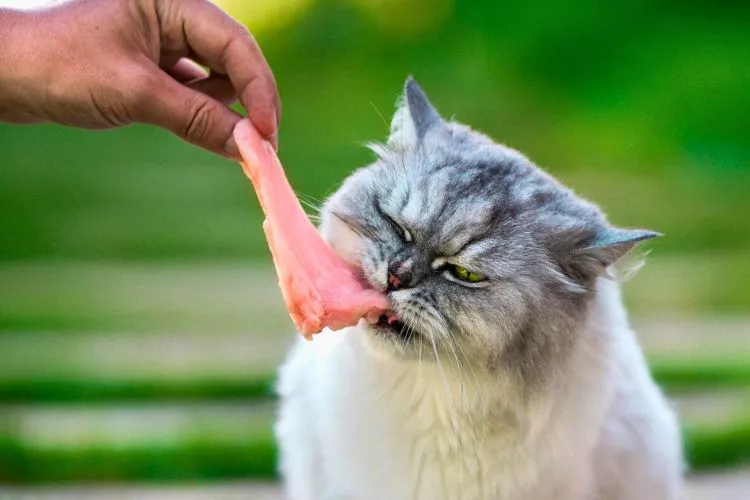
Most of us grew up believing that cats are natural carnivores that can safely consume raw meat.
On the other hand, concerns about foodborne illness and other risks have some cat parents questioning the wisdom of allowing their feline raw food.
🐾 Can cats eat raw chicken?
Yes, cats can eat raw chicken. However, knowing the potential risks of feeding cats a raw diet is important. It’s best to do plenty of research and consult your vet before feeding your cat a raw diet.
There’s no definitive benefit to raw over cooked meats, and the risks of contamination and disease are higher with raw diets.
If you treat your cat with a little raw chicken, ensure it’s fresh and doesn’t contain any seasoning that may be hazardous to their health.
Always follow safe food handling practices to minimize the risk of foodborne illness.
🐾 Can a cat get sick from eating raw chicken? The Potential Risks
While incorporating raw chicken into your cat’s diet may seem natural and beneficial, it isn’t without its concerns. Some of these complications could lead to significant health issues.
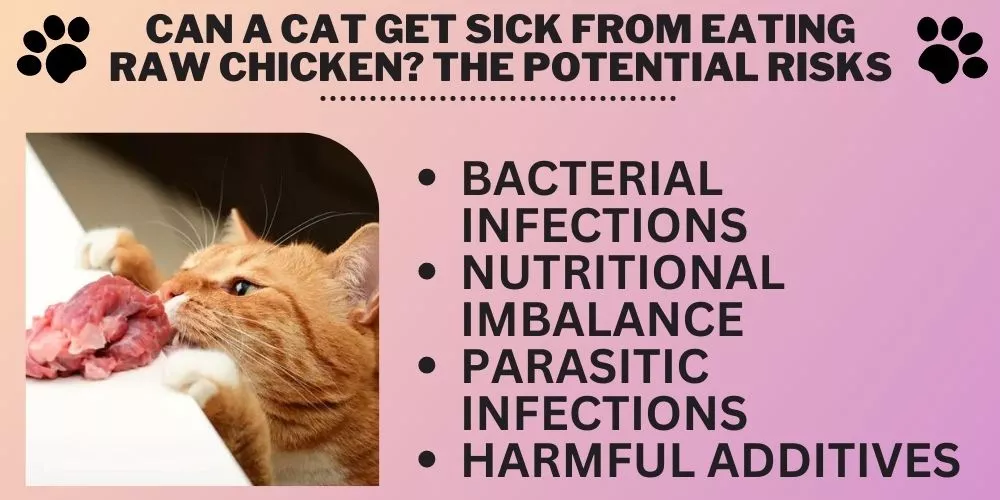
Bacterial Infections
The most immediate concern with feeding raw chicken to cats is the risk of bacterial contamination.
- Salmonella and Campylobacter: Raw chicken, even high-quality, free-range products, can harbor harmful bacteria, including Salmonella or Campylobacter. These pathogens can result in serious illnesses in both cats and humans they interact with. Cats’ symptoms may include vomiting, diarrhea, fever, and decreased activity.
- Transmission to Humans: Humans living in the same household can contract these bacteria if they come into contact with contaminated surfaces or through handling the cat’s waste. In humans, these bacteria can cause food poisoning, with symptoms such as fever, diarrhea, and abdominal cramps.
Nutritional Imbalance
Raw diets are complex and take careful planning to ensure your cat receives all the nutrients they need. One common pitfall is nutritional imbalance.
- Lack of Essential Nutrients: Cats have specific dietary requirements different from other animals (and humans). While high in protein, pure raw chicken meat falls short in providing all these essential nutrients.For instance, taurine, a critical amino acid, is often deficient in a chicken-only diet. Taurine deficiency can lead to serious cardiac problems in cats.
- Risk of Bone Ingestion: While some pet owners feed their cats raw chicken bones, believing it’s a source of calcium, it poses another risk. Choking or gastrointestinal blockage/injury can occur if the bones are not properly ground.
- Inconsistent Diet Quality: Another point to consider is meal-to-meal consistency. Do you have a foolproof plan to eat perfectly balanced meals daily? Missteps are easy when creating a homemade diet and can risk your cat’s health.
Overall, while the theory of feeding your cat a raw diet akin to its wild ancestors may initially seem beneficial, the potential risks can be quite severe.
Pet owners must be aware and informed of these concerns before deciding what goes in our pets’ food bowl.
Parasitic Infections
Raw chicken can harbour a range of parasites which can harm your feline friend.
- Toxoplasma Gondii: One of the most common parasites in raw chicken is Toxoplasma gondii, which can cause toxoplasmosis. Cooling and freezing methods in food preparation do not necessarily eliminate this parasite.Toxoplasmosis can lead to significant health issues in cats, particularly if their immune system is compromised. Symptoms can range from mild (fever, loss of appetite) to severe (neurological issues, respiratory distress, vision problems).
- Other Parasites: Other parasites like the roundworm Capillaria spp. can contaminate raw chicken. Long-term effects of parasitic infections can include weight loss, nutritional deficiencies, anemia, and in serious cases, organ damage.
Harmful Additives
It’s common for chickens to be injected with brine, seasonings, or other solutions to enhance flavor. Consequently, this poses another risk for cats.
- Onion and Garlic Derivatives: These flavor enhancers may contain onion or garlic derivatives that are toxic to cats, even in small amounts. They can cause oxidative damage to the red blood cells, leading to a condition known as Heinz body anemia.
- Other Harmful Substances: In addition to onion and garlic, these solutions may contain other harmful substances like excessive salts or preservatives, which could lead to issues such as increased thirst, kidney issues, and digestive upset.
Remember, you must fully understand the potential health implications of your feeding practices. When in doubt, always consult with a qualified veterinary professional.
🐾 The Potential Benefits
While risks exist, some cat owners advocate for a raw diet, citing the following benefits.
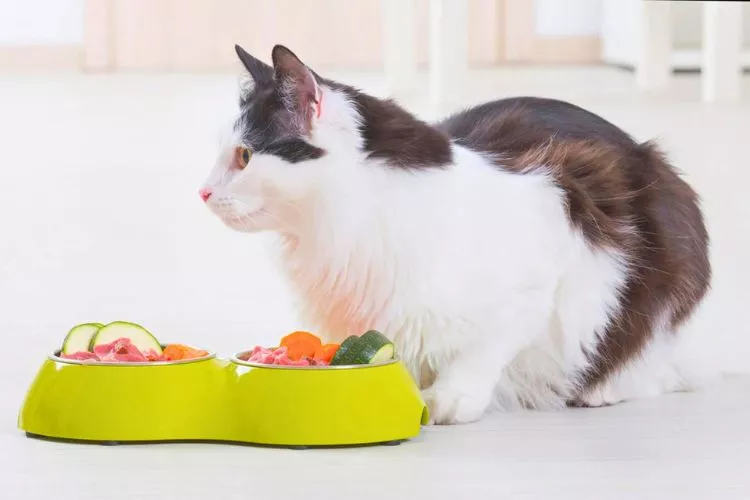
- Dental Health: Supporters of a raw diet believe the raw food and natural enzymes clean the teeth, reducing dental disease (often an issue in cats).
- Behavior: Raw diets can be more appealing than commercially prepared cat food, resulting in better meal engagement.
- Natural Diet: Raw diets protect cats from potentially harmful additives and ingredients in some cat foods. Cats are obligate carnivores with unique nutritional needs, which can be met by eating a diet primarily of animal tissue. Raw cat food diets focus on uncooked meat, fish, and internal organs to meet these needs.
In addition to the benefits listed above, raw diets may promote a healthier coat, increased energy, and improved digestion. However, it is essential to consult with a veterinarian before transitioning your cat to a raw diet, as improper preparation and handling of raw food could pose health risks, such as bacterial infections.
🐾 Precautions when feeding cats a raw meat diet
- Hand Hygiene: Wash your hands thoroughly with soap before handling raw meat, and always wash them again once you’re done.
- Clean Utensils: Any bowls, cutting boards, or knives used to prepare raw meat should be cleaned immediately afterwards to avoid cross-contamination.
- Serve Immediately: Once you’ve portioned the raw meat, serve it to your cat immediately. Don’t leave it out for a long time as this increases the chance of bacterial growth.
- Balanced diet: Ensuring a properly balanced diet is essential for your cat’s overall health. Consider consulting with your veterinarian or a pet nutrition specialist to create a well-rounded meal plan tailored to your cat’s specific dietary requirements.
- Transition slowly: If switching from a commercially-prepared diet to a raw food diet, gradually introduce the new food to your cat to avoid digestive issues. Start by mixing a small portion of raw food with their regular food and gradually increase the raw food quantity over several days.
- Monitor your cat’s health: Keep a close eye on your cat’s health, especially during the initial transition period. Pay attention to changes in energy levels, coat condition, and digestion. Regular check-ups with your veterinarian can help identify early signs of any health issues arising from the diet change.
- Be cautious with fish: While cats can eat raw fish, it contains thiaminase, an enzyme that can destroy thiamine, which is essential for cats. If you include raw fish in your cat’s diet, you must ensure they receive enough thiamine from other sources, such as supplements.
🐾 What kind of raw meat can cats eat?
Cats, as obligate carnivores, can consume various types of raw meat. Based on a search on Bing, a raw food diet for cats usually comprises the following components:
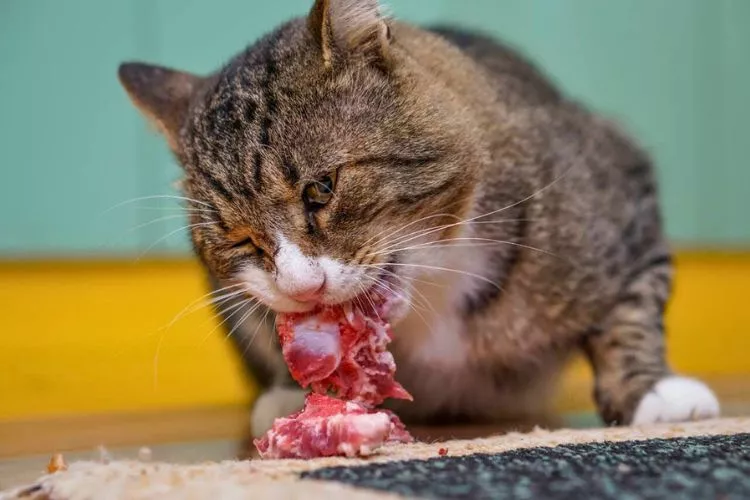
Raw muscle meat
Muscle meat, such as chicken, beef, rabbit, turkey, and lamb, provides essential nutrients like protein, amino acids, and fatty acids. Some popular cuts for a raw food diet include chicken thigh, breast, or wing meat, boneless beef cuts, rabbit leg, or shoulder meat.
Organ meat
Organ meats, like liver and kidneys, are vital for proper nutrient balance, as they are high in vitamins and minerals like iron, copper, phosphorous, and vitamin A. Organs can be sourced from chicken, beef, rabbit, and lamb.
Other organ options include heart, spleen, and pancreas. It is important to incorporate organs at the proper ratio in a raw diet; following prey-model guidelines, organs should make up about 10% of the diet with the liver comprising half of that amount.
Ground bones or bone meal
Ground bones or bone meal are included in raw diets to provide calcium and phosphorus, essential for cats’ bone health and growth. Edible bones such as chicken necks, wings, and backs may be used.
Alternatively, some people use bone meal, a ground form of animal bones, as a calcium supplement.
When preparing a raw diet for your cat, achieving the right balance of nutrients is crucial for their health and well-being. Consulting a veterinarian or a pet nutrition specialist can help ensure the proper formulation of your cat’s diet.
🐾 How to Prepare Raw Chicken for Cats?
Feeding your cat a raw chicken diet can help provide essential nutrients, like protein, amino acids, and fatty acids. However, ensuring a balanced diet and maintaining proper hygiene during preparation is crucial.
Here are the steps to prepare raw chicken for your cat:
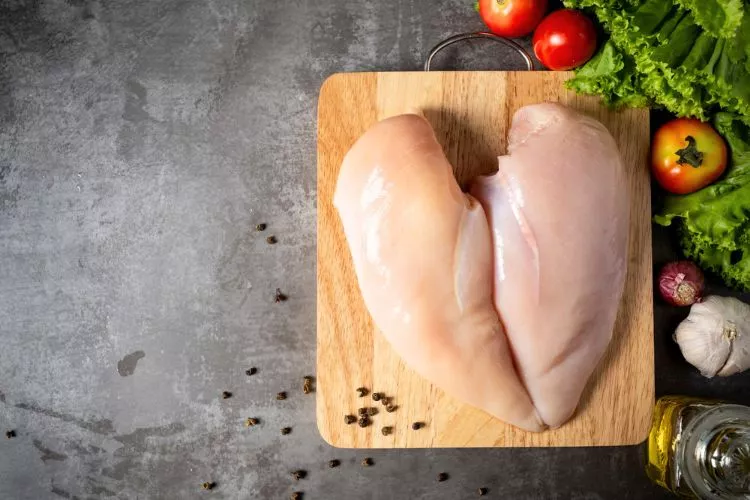
Select a high-quality, fresh chicken
Look for fresh chicken from a trusted source. Ensure the chicken is pink, not gray or slimy. Organic or free-range options are preferable, but not required.
Portion the chicken
Cats can eat various parts of the chicken, including the muscle meat and bones. While preparing the raw chicken for your cat, keep the following in mind:
- Muscle meat: Most of your cat’s diet should include muscle meat, such as the breast, thighs, or wings. Trim away excess fat, skin or connective tissue, as too much of these could cause digestive issues.
- Edible bones: Edible bones, such as chicken necks, wings or backs, can help provide essential minerals, like calcium and phosphorus. Be sure not to give cooked bones, as they can splinter and cause injury.
- Organs: Although not found directly in the chicken, organs such as liver, kidney, or heart should also be included in your cat’s diet to provide essential nutrients. Organs should comprise around 10% of your cat’s diet, with half being liver.
Maintain proper hygiene
To minimize any risk of bacterial contamination:
- Wash your hands thoroughly with soap before handling raw chicken and after you are done.
- Clean and sanitize all surfaces, utensils, cutting boards, and knives used in the preparation process.
- Store the raw chicken in a covered container in the refrigerator, and freeze any leftovers until ready to serve.
Feed the appropriate amount
Consult your veterinarian to determine the appropriate amount of food based on your cat’s age, size, and activity level.

Ensure to monitor your cat’s health regularly. Regular veterinary checkups can spot any potential health issues from the diet change, and consulting a pet nutrition specialist can help fine-tune your cat’s dietary needs.
🐾 frequently asked question (FAQs)
Yes, cats can get worms from raw chicken, specifically roundworms. Raw meat and chicken can contain parasites like Toxocara cati, leading to roundworm infestations. To minimize the risk, use fresh, high-quality chicken, and consider freezing it for several days before feeding it to your cat.
The amount of raw chicken to feed your cat depends on age, size, and activity level. As a general guideline, adult cats require about 2-4% of their body weight daily. For example, a 10-pound cat would need about 3.2 to 6.4 ounces of raw chicken daily. Consult your veterinarian for specific recommendations for your cat’s needs.
While cats can eat raw chicken every day, it’s important to maintain a balanced diet by including other protein sources, organ meats, and essential nutrients. Feeding only raw chicken can lead to nutritional imbalances, so consult your veterinarian or a pet nutrition specialist to create a well-rounded meal plan for your cat.
If your cat ate a small amount of raw chicken, monitor them closely for signs of digestive upset, such as vomiting or diarrhea. If no symptoms develop, be cautious about feeding raw food in the future to avoid health issues. If your cat shows any signs of illness, contact your veterinarian for advice and potential treatment options. Always ensure proper handling and storage of raw meat to minimize the risk of bacterial contamination and parasites.
Conclusion :
Cats can indeed eat raw chicken as a part of a balanced, nutritious diet. Raw chicken provides essential nutrients like protein, amino acids, and fatty acids, contributing to their overall health.
However, it’s crucial to include other protein sources, organ meats, and essential nutrients to avoid nutritional imbalances in your cat’s diet.
When handling and feeding raw chicken, always maintain proper hygiene to minimize the risk of bacterial contamination and parasites.
As with any dietary change, you must consult your veterinarian or a pet nutrition specialist to determine the appropriate meal plan to meet your cat’s unique needs and ensure their long-term health and well-being.
